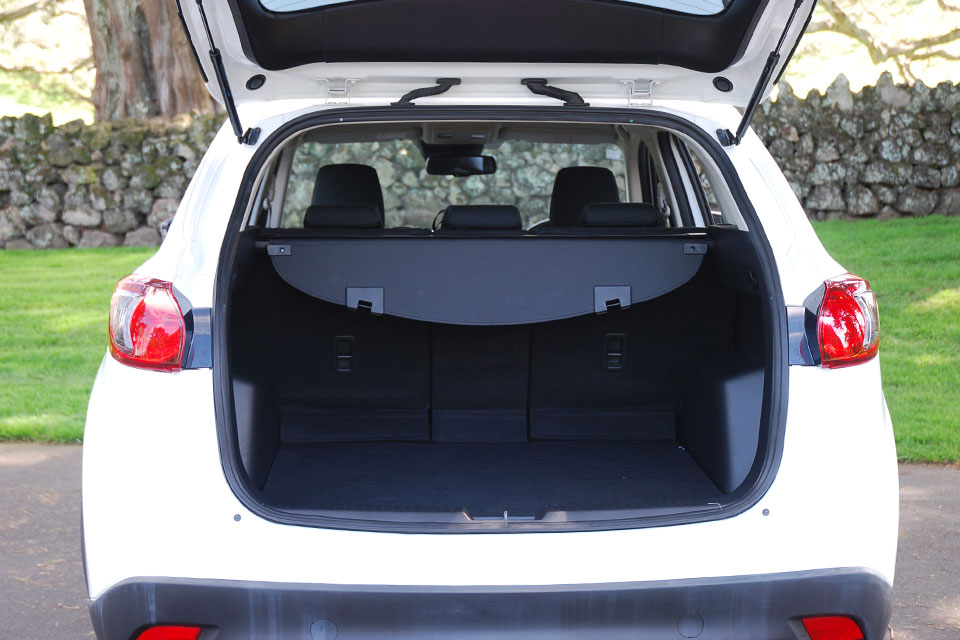Mazda CX-5 2012-2017 used car review
The Mazda CX-5 looks sharp inside and out and is excellent to drive.

The Mazda CX-5 looks sharp inside and out and is excellent to drive. It's popular and can be pricier than its competitors to buy.
Mazda launched the CX-5 in 2012 to replace both the CX-7 and the Tribute. It was a success and was named the Japanese Car of the Year for 2012. The CX-5 features the brand’s SkyActiv technologies, which are a group of engine, transmission and chassis designs aimed at improved efficiency.
Inside and out
The Mazda CX-5 looks a lot like the small Mazda 3 hatchback. It has a similar large grille and body shape. The bottom of the body is clad in black plastic. This offers some protection in off-road conditions, though is also a design trick to hide some of the vehicle’s bulk and make it look like it is riding higher.
Alloy wheels are standard on all models, and our review car features sporty twin exhaust pipes. We were very impressed with the feel of the Mazda’s interior. Everything seems well assembled and of high quality. The dash and door trims are made from a soft-to-touch material and the steering wheel is finished in leather. A dark black glossy trim runs across the dash.
The instruments sit in three chrome-ringed pods with start/stop buttons close to them on the left. The centre console features an aftermarket touchscreen infotainment system, which in this case will require a band expander to receive local stations. Below this are the controls for the climate system which has separate temperature settings for the driver and passenger.
The front seats are reasonably comfortable. They look sculpted but do not offer a lot of side support in corners. The rear seat has good legroom, although the cabin feels narrow and only two adults or three children will be comfortable on anything more than short trips. The whole car feels a little closed in and dark, largely due to the black dash and gray seats.
The boot is about average for the class with 403 litres of cargo space. It is a clean, square area and is easy to fit in bulky items - we expect four large cases will go in. The rear seat splits in three and folds forward to expand the load space up to 1,560 litres - levers on either side of the boot allow this to be done without the need to go around to the side door.
There is no spare tyre; a can of repair fluid and a compressor are stored under the boot floor. If you travel to remote areas, you might wish to consider adding a spare, even if it eats into the available space.
On the road
Three engines are available in the CX-5: 2-litre and 2.5-litre four-cylinder petrol engines and a 2.2-litre four-cylinder turbocharged diesel. All CX-5s sold in New Zealand use a six-speed automatic transmission that can be shifted manually.
Both front-wheel drive and all-wheel drive options are available. Our review vehicle was a front-wheel-drive model, powered by the 2.2-litre diesel engine. This produces 129kW and 420Nm and feels very strong - acceleration is brisk and more like a turbocharged petrol engine than a diesel. It is also quiet and refined for a diesel. The transmission is smooth and chooses its shifts well.
The CX-5 features an “I-stop” stop-start system that automatically shuts the engine off when the car is stationary. This improves fuel efficiency. The CX-5 drives like a well set-up car. The steering is well weighted and responsive.
The ride is firm yet comfortable. There is little body roll in comparison to some cars, let alone SUVs. This feels like a high-riding hatchback and drives better than some normal height cars. Don’t expect much from it off-road, however - ground clearance is low and the front bumper can catch on the ground over uneven surfaces. Our review vehicle was front-wheel drive and on a slippery road has no real advantage over a normal car.
Visibility forward from the driver’s seat is good, but to the rear it is poor.
Luckily, reversing cameras are fitted to all New Zealand-new and most used import cars. Our model also features a side camera, which allows you to see how close you are to the kerb - very handy for parallel parking.
The CX-5 has an average tow rating for its size and can pull 750kg unbraked (a small-to-medium garden trailer), and 1,800kg braked (a medium trailer boat). All-wheel drive models will be handier on slippery boat ramps.
Safety
RightCar lists the CX-5 as having a five-star ANCAP rating (2012 and onwards). This technically only applies to New Zealand-new models, though used import vehicles feature the same high level of safety features. They include driver and passenger, side and curtain airbags, traction control, electronic stability control, collision alert system, emergency brake assist and electronic brake-force distribution.
From 2015, New Zealand-new GSX and Limited models and “Proactive” package imports have advanced safety features, such as autonomous emergency braking, lane-keeping assist and adaptive cruise control.
ISOFIX child seat mounts and top tethers are found in the window positions at the back. All three rear seats feature full shoulder-type belts, which offer more protection than the lap-only type.
Reliability
The CX-5 is relatively new with few significant issues recognised yet. All engines use a timing chain, which will not need regular replacement.
However, the 2.2-litre SkyActiv diesel engine variants have shown some issues. Like most modern diesel engines they use a “diesel particulate filter” system to reduce emissions. Repetitive short trips can cause this to fail, which will result in a diesel fuel leak back into the engine oil sump.
As the diesel fuel accumulates in the sump oil over time it raises the oil level and pressure.
If left unchecked, it can ultimately cause the sump oil itself to become part of the compression ignition cycle and cause the engine to “run away”. That can result in complete engine failure.
Early engines were recalled and repaired - is important to check if this has been done, particularly on used import cars. There are also reports of turbocharger failure with this engine, along with excessive camshaft wear. However, these cases are so rare it is unclear if they are ongoing issues.
Cost of ownership
Mazda recommends servicing the CX-5 every year or 10,000km, whichever comes first. That is more frequent than other SUVs, although Mazda’s services are at a fixed price: $349 for the diesel model and $279 for the petrol.
RightCar estimates the diesel model will cost $1,960 in fuel and Road User Charges over 14,000km of driving a year. The 56-litre fuel tank costs $81.20 to fill at $1.45 per litre and will take you only 690km before the fuel light comes on.
A vehicle licence for the CX-5 is $155.69 a year, with the car in the cheapest ACC levy group for diesel.
Trade Me Insurance estimates insuring a CX-5 valued at $22,740 will cost $58.94* per month. That’s $4 more expensive than a Toyota RAV4.
Buyers' guide
The Mazda CX-5 is available on Trade Me priced from $16,000 to $50,000. The most expensive cars are demonstrator vehicles still being cleared from dealerships. The CX-5 is in demand and pricier than its competitors on the used market.
There’s a plentiful supply of the two-wheel drive GSX model and it offers the best value, with a good level of specification for a lower price than the all-wheel drive version.
Late-model New Zealand-new versions come with the bonus of a five-year factory warranty and three years of free services. Special conditions apply.
The CX-5 is one of the models coming to New Zealand as “statutory write-off” vehicles from Australia. It can be difficult to tell if these cars have had minor or major damage, or if they have been repaired correctly.
Australian models are relatively easy to identify because the variants are badged either Akera or Maxx. A MotorWeb vehicle history check will give you a clearer picture.
New Zealand models
- GLX - Powered by a 2-litre petrol engine with front-wheel drive. Features 17-inch alloy wheels, fabric upholstery, manual air-conditioning, reversing camera, cruise control, Bluetooth, CD player stereo, front, side and curtain airbags, and electronic stability control.
- GSX - Powered by a 2-litre petrol engine with front-wheel drive, a 2.5-litre petrol or 2.2-litre diesel with all-wheel drive. Adds keyless entry, leather steering wheel, a satellite navigation system, automatic headlights and wipers and fog lights. From early 2015 adds lane-keeping, blind-spot monitor, adaptive cruise control, collision warning and autonomous emergency braking.
- Limited - Powered by a 2.5-litre petrol or 2.2-litre diesel engine with all-wheel drive. Adds 19-inch alloy wheels, full leather interior, premium audio system, adaptive headlights, electric front seats with memory function and heating, and sunroof.
Japanese models
- 20S - Powered by a 2-litre four-cylinder petrol engine and front-wheel drive only. Features 17-inch alloy wheels, fog lights, keyless entry and start, automatic lights and wipers, automatic stop-start, separate temperature settings for the driver and passenger, corner and side cameras, front, side and curtain airbags and electronic stability control.
- XD - Powered by a 2.2-litre turbocharged diesel engine with front or all-wheel drive. Specification the same as 20S.
- 25S - Powered by a 2.5-litre petrol engine with front or all-wheel drive. Specification the same as 20S.
All models are commonly fitted with one or both of two options packs:
- L Package - Adds full leather seating, heated front seats, electric driver's seat and 19-inch alloy wheels.
- (From 2015) Proactive Package - Adds lane keep assist, blind-spot monitor, adaptive cruise control, collision warning and autonomous emergency braking.
Timeline
- 2012 Launched globally
- 2014 Receives slight facelift and updated specification
- 2017 Replaced by new model
Details
2012 Mazda CX-5 XD
$18,000 to $34,990 for models which have travelled 70,000 to 120,000km
2.2-litre four-cylinder turbocharged, 129kW and 175NM
Six-speed automatic, front-wheel drive
Five-star ANCAP rating
10,000km or 12 months
Tyre repair kit
7.4-litres per 100km (claimed)
Diesel
4540mm
1840mm
1670mm
750kg (unbraked), 1800kg (braked)
11.7m
This review covers the Mazda CX-5 for model years 2012, 2013, 2014, 2015, 2016 and 2017.
Review vehicle supplied by Turners Cars.
*Our insurance estimates are based on a 35-year-old male with no accidents in the last two years, garaging the car in Mission Bay, Auckland. The car is not used for business and will cover 10,000km to 20,000km a year. We estimate with no option add-ons and $500 excess. Customise your estimate at Trade Me Insurance.
Image gallery
Also consider






